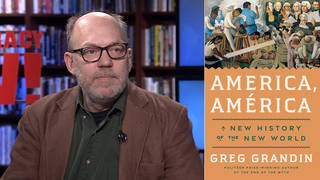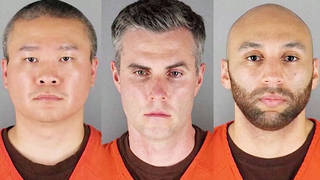
Guests
- Derrick Sanderlinanti-bias trainer with Future of Justice Training and a San Jose community organizer.
As protests against racism and police violence continue across the United States, we speak with Derrick Sanderlin, a San Jose community organizer who has spent years training police on avoiding implicit bias toward people of color, but an officer from the same police department shot him in the groin with a rubber bullet during a May 29 protest against racism and police violence, rupturing Sanderlin’s testicle and possibly affecting his ability to have children.
Transcript
AMY GOODMAN: This is Democracy Now!, democracynow.org, The Quarantine Report. I’m Amy Goodman, as we turn now to look at police violence against protesters who have taken to the streets following the Minneapolis police killing of George Floyd three weeks ago. Across the country, activists have been beaten, tear-gassed, maced, shot, arrested en masse. Nonviolent protesters and journalists alike have lost eyes, been rammed by cars and trucks, suffered broken limbs.
Well, we’re going to San Jose, California, where police shot their own anti-bias trainer in the groin with a rubber-coated steel ball bullet, bursting his testicle. Derrick Sanderlin is 27 years old, African American. He spent years training police cadets in San Jose about how to avoid implicit bias toward people of color. He was shot while taking part in a protest on May 29th. San Jose Police Chief Eddie Garcia has released a statement saying Sanderlin, quote, “has been a real leader in our communities’ efforts to reduce bias and discrimination through dialogue,” unquote, and vowed to investigate. But Garcia has also defended the use of force by his officers during the recent protests. Derrick Sanderlin joins us now from San Jose.
We welcome you to Democracy Now! You’re an anti-bias trainer with the Future of Justice Training, a San Jose community organizer. Thanks so much for being with us. I’m so sorry for what has happened to you. Can you go back to that day, to the protests after the killing of George Floyd, and tell us what happened? Set the scene for us, Derrick.
DERRICK SANDERLIN: Absolutely, yeah. We were starting to gather at City Hall. And I’ve got to say, I really wasn’t sure how many people were going to be there. I think, following the death of another Black — a Black person in America, the protest in San Jose was like one of the biggest I’ve ever seen here in this city. And so it was beautiful to see. It was very peaceful, even as we started to cause some disruption in traffic. Cars were honking along with us and rooting us on. We blocked the freeway, which is when police started to sort of show up.
And as tensions started to rise, there was an increasing need to just like quell the tension between police officers and community members, particularly when, on our way back to City Hall, the police department decided to sort of follow behind us in a line of police officers and start firing rubber bullets into the crowd. I, yeah, saw old women being shot, kids being shot and, you know, just a continued push toward City Hall.
AMY GOODMAN: So, Derrick, tell us what you did then. You put your hands up and walked between —
DERRICK SANDERLIN: Yeah.
AMY GOODMAN: — the protesters and the police?
DERRICK SANDERLIN: Precisely. So, as I was watching a young woman get shot by a rubber bullet directly in the chest, I just couldn’t watch anymore. I just kind of put my hands up and walked sideways over there, as they were searching around, and asked them to please not do this. And, you know, they were sort of, you know, at bay for the moment.
And as I was continuing to say just, you know, “Please don’t do this,” another cop came up from behind them and pointed his riot gun right at me and said, “Move.” And I just kind of pulled my sign over my chest and, with a lot of fear, was just kind of shaking my head no. And he said, “You’re not going to move?” And I just kind of stood there. And he fired his riot gun.
And I didn’t realize until impact that he had been aiming at my groin. And yeah, I fell to the ground, but luckily there were a couple people who I knew who were standing nearby when everything unfolded, and I was luckily taken away from harm’s way after that.
AMY GOODMAN: So you were taken to the hospital?
DERRICK SANDERLIN: I actually didn’t go to the hospital that night, even though it was the worst pain that I’ve ever experienced. I figured, you know, ice and sleep it off, I’ll be OK. These things happen, you know. But the pain got worse, and the condition got worse. And I just — I called my doctor, and they sort of suggested that I take a radiology test, and if things get worse, that I go into the hospital. So, I did that Saturday night. And they discovered that there’s a strong possibility that I had a ruptured testicle. So I went into emergency surgery Saturday night and went home Sunday morning.
AMY GOODMAN: And what is your prognosis? What did the doctor say?
DERRICK SANDERLIN: So, after the emergency surgery, there was a ruptured testicle. But, yeah, right before the surgery, he said, “If it is ruptured, there’s a possibility that having kids can be complicated. You can — your body can create an antibody against yourself. And yeah, you won’t know until you try, but there’s a possibility that you may not be able to have children.”
AMY GOODMAN: Have you been talking with your partner about having kids?
DERRICK SANDERLIN: Yes. We actually, a couple weeks before the protests, were sort of planning, you know, when we’re going to start thinking about having kids. So, definitely a desire.
AMY GOODMAN: I wanted to ask you about the San Jose police chief, Eddie Garcia, personally calling you after you were shot, and then releasing the statement saying, “Derrick has been a real leader in our communities’ efforts to reduce bias and discrimination through dialogue. I assured him we will be investigating this incident,” he said. However, in the past he has defended his officers’ conduct during protests, and San Jose Police Captain Jason Dwyer compared policing the streets during protests to being in a, quote, “war zone.” Now, the fact that you are an anti-bias trainer of the San Jose Police Department, can you explain the work you’ve been doing for years there?
DERRICK SANDERLIN: Yes. So, we are — I belong to a team called the Beloved Community. We’re community organizers. And one of the particular things that we do in our work for police accountability is talk to police officers about the cultural and historical history of policing that they step into when they put on their uniform. And in doing so, they are also opening what we like to call a bank account at the Community Bank of Trust. And, you know, you can either make deposits or withdrawals from that Community Bank of Trust, but you have to make that choice consciously. And whether you like it or not, folks are sort of engaging with you based on their historical and cultural context with policing and law enforcement. And that’s essentially what we do for cadets and officers who have to retake the class or who haven’t taken the class in the past.
AMY GOODMAN: Derrick, did you know any of the officers on the line?
DERRICK SANDERLIN: Unfortunately, I couldn’t pick them out, you know, but —
AMY GOODMAN: Were they fully covered with shields?
DERRICK SANDERLIN: They were covered with — they didn’t have the riot shields, but they did have the face — the plastic face masks. And yeah, unfortunately, some of them have been on the force for years, and some of them I’m just like not familiar with. But —
AMY GOODMAN: And your response to the police chief calling you directly, Police Chief Garcia, and yet — rather, the mayor [sic] calling you directly, and the police [captain] calling the area a “war zone”?
DERRICK SANDERLIN: Unfortunately, the conversation that the community has been having out here is, if our public officials perceive what happened on the 29th, the 30th and the 31st as a war zone, then it sort of assumes that someone — that our community is being — you know, that the war is between the community and the police, which is a strange way to paint the community that you’re called to serve. I respect the chief a lot. And I do know that —
AMY GOODMAN: Sorry, I misidentified. The chief is Eddie Garcia?
DERRICK SANDERLIN: Yes, that’s right.
AMY GOODMAN: Yes.
DERRICK SANDERLIN: Chief Garcia. I do — yeah, I do respect Chief Garcia and respect the mayor. It’s clear that this isn’t working. And it’s disappointing to continue to hear, yeah, anything less than “Let’s try to move forward in the transformation.”
AMY GOODMAN: What do you demand of the police department right now?
DERRICK SANDERLIN: I have been holding a lot tension over the years with a lot of the deaths that have happened in the city. I think it’s high time that we listen to the families that have experienced that, and defund the police department, divest from school cops and internal investigations, things like this, in order to reinvest into the community, have better school programs, have a strengthened civilian oversight that’s independent from the police department. And just really, I’m asking my city officials to listen to their community when we say we need to reimagine public safety.
AMY GOODMAN: And your thoughts when you heard that Rayshard Brooks had been killed now in Atlanta, like you, a 27-year-old African American man?
DERRICK SANDERLIN: Yeah, that seriously — that seriously broke my heart, especially given some of the words from Killer Mike. I’ve never been to Atlanta. I don’t know anything about Atlanta. But I have heard of the Mecca, and so it’s difficult to hear.
And what’s even more difficult to hear is the death of Christopher Booker, the alleged lynching. I grew up in Victorville, California is my state, and so, familiar with the presence of just devastating bias. And I hope this wakes the country up.
AMY GOODMAN: Well, Derrick, I want to thank you so much for being with us. And also, just to clarify, since I misidentified them, the police chief of San Jose is Eddie Garcia, and it’s the San Jose police captain, who’s Jason Dwyer —
DERRICK SANDERLIN: That’s correct.
AMY GOODMAN: — who called the protest zone a “war zone.”
DERRICK SANDERLIN: That’s correct.
AMY GOODMAN: Derrick Sanderlin, thanks so much for being with us, anti-bias trainer with Future of Justice Training and a San Jose community organizer. Thanks for joining us.
When we come back, a New York police officer is charged with assault, criminal mischief, harassment and menacing for violently shoving a 20-year-old woman at a recent protest against police brutality. She was hospitalized with a concussion. We’ll speak with Dounya Zayer and her attorney. Stay with us.













Media Options